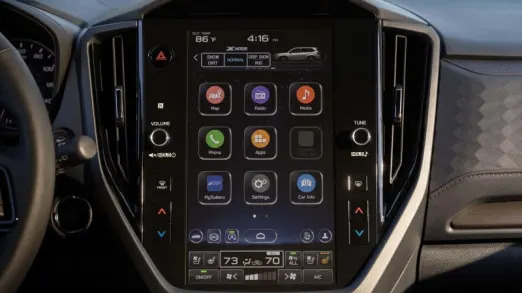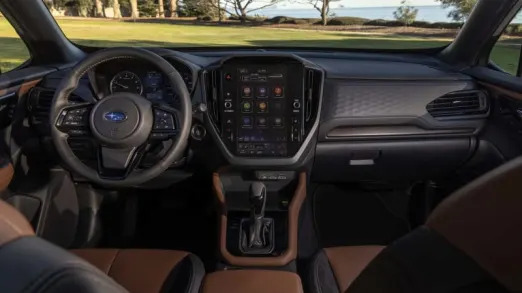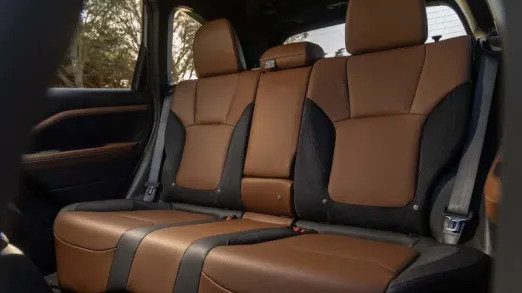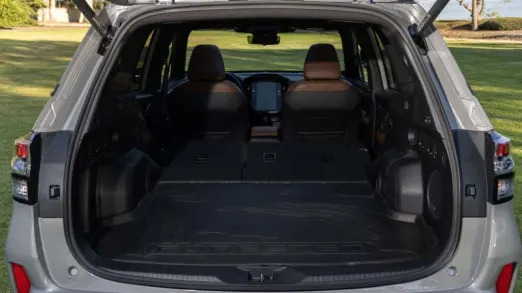Pros: Above-average ride; slick cabin design; exceptional visibility; extra capability of the Wilderness
Cons: Infotainment is new to Forester, but antiquated compared to rivals; Wilderness misses out on upgrades
On paper, the 2025 Subaru Forester is brand new, but compared to the legitimately overhauled Honda CR-V, Kia Sportage and Hyundai Tucson of recent years, this generation didn’t exactly start with a clean slate. While very little has changed under the skin, the looks are certainly different enough to cue double takes in the REI parking lot. There will be no mistaking the 2025 for a 2024, unless of course it’s a Wilderness model, in which case, well, it is totally the same as 2024. The outgoing off-road variant will continue to be produced alongside the new Forester until a replacement Wilderness is ready to roll.
On paper, it’s hard to spot the differences between the outgoing model and the 2025 Forester. The new version uses the same Subaru Global Platform and 2.5-liter boxer-four. It has the same wheelbase, height and track width, while only adding 0.6 inches to the length and 0.5 inches to its width. The cargo area expands by a whopping 0.7 cubic feet behind the raised back seat. Yes, that was sarcasm. Behind the scenes, however, it’s not so cut-and-dried. The process of putting together the underlying chassis was improved, and it now utilizes more structural adhesives, making it stronger and stiffer than the outgoing Forester’s. Handling, ride and interior noise levels benefit. The steering is also enhanced, now incorporating a version of the WRX’s dual-pinion electronic rack.
And there’s more to come in the form of both an updated Wilderness model and a new hybrid powertrain. Look for both of those in 2025. As it currently stands, though, the Forester is certainly improved, but not so much in a way that changes our overall impression of this popular compact SUV: it’ll hit the target dead-on for some, especially those with an outdoorsy mindset, but most others will find rivals (specifically those mentioned above) do a better job in key areas.
Interior & Technology | Passenger & Cargo Space | Performance & Fuel Economy
What it’s like to drive | Pricing & Trim Levels | Crash Ratings & Safety Features
What’s new for 2025?
The 2025 Subaru Forester was substantially overhauled for 2025 (though we wouldn’t call it all-new) and you can read about the changes in our 2025 Forester first drive review.


What are the Forester interior and in-car technology like?
The interior design may be new to the Forester, but it’s virtually indistinguishable from what you’ll find in the Outback, Crosstrek and Ascent. Apart from some dimpled surfacing on the passenger-side dash, you really can’t tell the difference. Admittedly, the included 11.6-inch portrait-oriented touchscreen (and the weird dual 7-inch screen setup of the base model) doesn’t leave designers much room to work with. Both of the available touchscreen infotainment systems are indeed new to the Forester, but again, old-hat for the Subaru lineup. Which means they’re pretty old-hat, period, at this point.
While the 11.6-inch system display offers decent resolution and plenty of tech behind the polish, the system itself can be clumsy and difficult to interact with, occasionally ignoring inputs or lagging during menu-diving. The perma-docked options on the home screen are handy, but make for a cluttered aesthetic. To Subaru’s credit, most of the regularly used functions are included in that jumble, but some simple actions require extra steps. Enabling climate control recirculation requires navigating to the climate control page, for example. When you smell skunk, you want to hit a button and make it go away, not hunt through options while the ammonia burns your nostrils.
This generation also gets a wireless phone charger, ventilated seats and hands-free power liftgate. The seats are also more supportive, according to Subaru, and have been slimmed down for better visibility and access to the rear seats. Little hooks have been added throughout the cargo area, including two in the roof at the base of the liftgate – those were introduced for, and had been exclusive to, the Wilderness.


How big is the 2025 Subaru Forester?
Since not much has changed in external dimensions, the 2025 Forester’s cabin is virtually the same size as its predecessor’s, lining up nicely with the Honda CR-V, Toyota RAV4 and Hyundai Tucson. Backseat space differs more between them, but they’re all generously spacious and well within the realm of “family friendly.” Since it was already one of the most spacious compact “SUVs,” we can see why Subaru didn’t bother messing with the formula. The 2025 also retains the old Forester’s generous rear side windows (visibility is exceptional) and the ample recline of its seat back.
In terms of cargo space, the Forester’s 29.6 cubic feet (or 26.9 with its jumbo sunroof) seemingly falls nearly 10 cubic feet short of the Kia Sportage, Hyundai Tucson, Toyota RAV4 and Honda CR-V. But curiously, the Forester has consistently outperformed its specs in the real world. When we load it with bags, the Forester tends to keep up just fine.
It’s also worth noting the Forester’s class-leading ground clearance. At 8.7 inches, nothing can match it now that the Jeep Cherokee Trailhawk has been discontinued, although the Toyota RAV4 TRD Off-Road and Adventure comes close at 8.6. Remember, this is the base Forester, not a special off-roading trim; that’s where Wilderness comes in. The Forester’s own special off-roading trim cranks things up to 9.2 inches and shaves off some bumper to further improve its approach angle.

What are the Forester’s fuel economy and performance specs?
A 2.5-liter naturally aspirated boxer-four carries over from 2024 and now delivers 180 horsepower and 178 pound-feet of torque. That’s a decrease of two apiece — bummer. It’s still connected to a standard CVT, albeit with smoother and quieter performance, according to Subaru. Most trim levels have paddle shifters to select eight simulated ratios. The base Forester is rated at 26 mpg city, 33 mpg highway and 29 mpg combined. The Sport and Touring models check in at 25/32/28.
While we’d still like to see the turbo engine return, Subaru has not given us any indication that it’s going to happen. A hybrid version is on the way for certain, though. Expect more on that in early 2025 — one year after the gasoline model’s launch.
The standard all-wheel-drive system has been revised to react quicker, improve handling and provide better control both on- and off-road. An X-Mode off-road driving mode is included on the Forester Premium, while the Sport and higher trims get two mode options based on terrain and traction.
What’s the 2025 Subaru Forester like to drive?
The 2025 Forester feels tight and composed, with diminished wind and road noise compared to the outgoing model. The new steering setup isolates the driver from wrist-yanking kickback over sharp impacts without significantly diminishing steering feel, plus it eliminates the awkward shimmies and jiggles that were previously induced by potholes and speed bumps. The Sport, which gets a sharper suspension, even manages to feel genuinely taut, but without any power to back up the handling, we’d struggle to recommend even the Sport to anybody who craves horsepower. Peak torque now comes on at 3,700 rpm rather than way up at 5,400 rpm, which improves drivability but does nothing for ultimate performance. Acceleration is smooth and perfectly adequate as a result, but the praise ends there.
While it’s not a 2025, the Forester Wilderness remains on sale. While it’s based on the older Forester design, the off-road-focused trim offers grippier all-terrain tires, and we were truly impressed with how adept it was at responding to last-second steering corrections. And when we failed to avoid things, the Wilderness’ extra suspension travel and retuned dampers did a sensational job of cushioning the impacts, and in general did a tremendous job sopping up bumps and ruts off the beaten path. For the type of off-roading its owners are likely to do, the Forester Wilderness is absolutely perfect. The regular Foresters are obviously not at the same level in this regard, but are still better-suited than the Honda CR-Vs, Nissan Rogues or Mazda CX-5s of the world.
What other 2025 Subaru Forester content can I read?
2025 Subaru Forester First Drive: Improved but incomplete
An updated Wilderness model and hybrid powertrain should fill in the blanks

Subaru Forester Wilderness First Drive Review | Take a hike
The more rugged Forester is a better and more interesting Forester.

Subaru Forester Luggage Test | How much cargo space?
Since the cargo area has barely changed, the 2025 Forester should be able to carry the same amount of stuff as the previous-generation model.

What is the 2025 Forester’s price?
In keeping with its strong value proposition, the updated Forester will start at $31,090 (with destination) — a few hundred dollars cheaper than the least-expensive, front-wheel-drive 2024 Honda CR-V.
That said, we’re not too enthused about the standard Sport model or its dual 7-inch screens. You’ll find the 11.6-inch portrait-oriented touchscreen (with its wireless Android Auto and Apple CarPlay) on the Premium ($33,390) and up; the Limited hits the sweet spot for equipment — including a heated steering wheel and power hands-free liftgate — without breaking the $40,000 barrier.
Here’s a breakdown of starting price for each 2025 Forester trim including destination charge ($1,395):
- 2025 Subaru Forester CVT: $31,090
- 2025 Subaru Forester Premium CVT: $33,390
- 2025 Subaru Forester Sport CVT: $35,890
- 2025 Subaru Forester Limited CVT: $37,390
- 2025 Subaru Forester Touring CVT: $41,390
The outgoing Forester Wilderness will remain in production alongside the new model. It checks in at $36,265 including destination.
What are the 2025 Forester’s safety ratings and driver assistance features?
The latest version of Subaru’s EyeSight driver assistance suite comes aboard the Forester, promising smoother and quicker reactions under a greater range of conditions. The cameras have a wider field of view, the control software has been updated and an electric brake booster added; cyclists and pedestrians will be detected sooner.
One bit of safety gear that’s actually new to the Subaru family: Emergency Stop Assist, which automatically brings the vehicle to a stop, activates the hazard lights and unlocks the doors should the driver become unresponsive while using adaptive cruise control. That’s a pretty big caveat but it’s still a good idea.
Subaru anticipates the Forester will retain its IIHS Top Safety Pick status for 2025; neither of the third-party safety organizations has tested the new model yet.
Related video:


